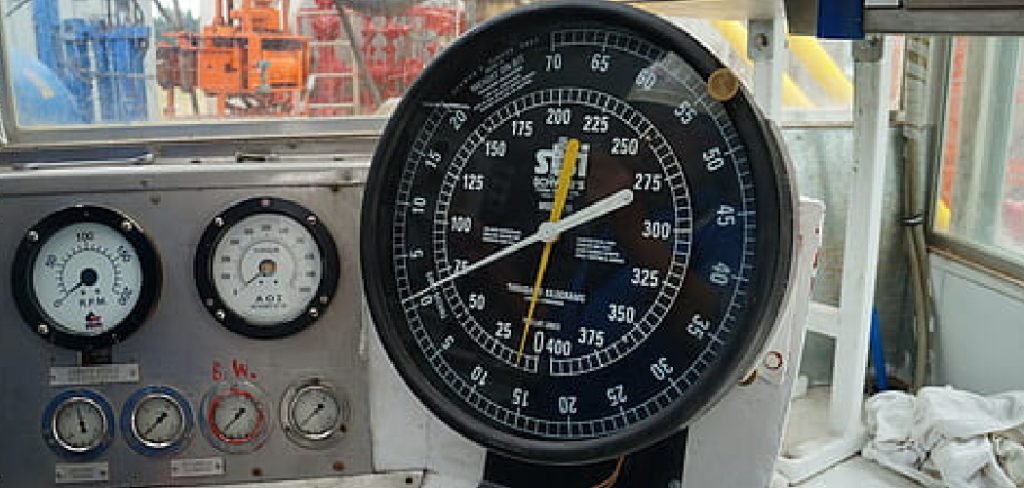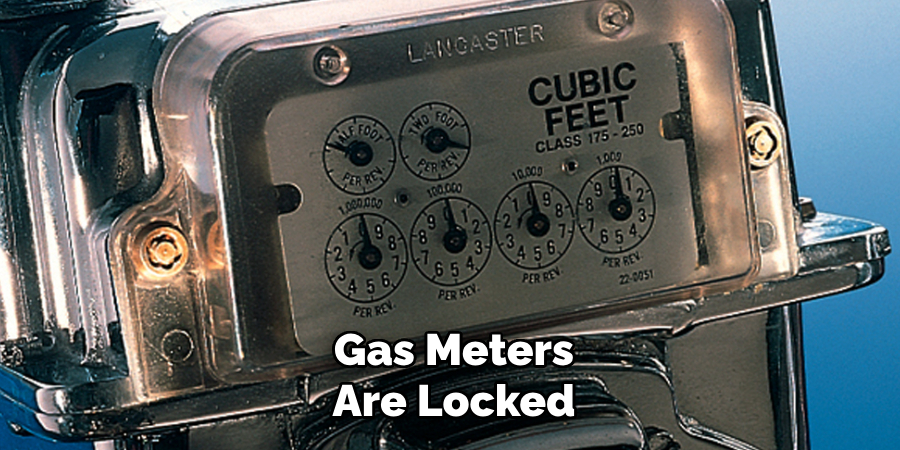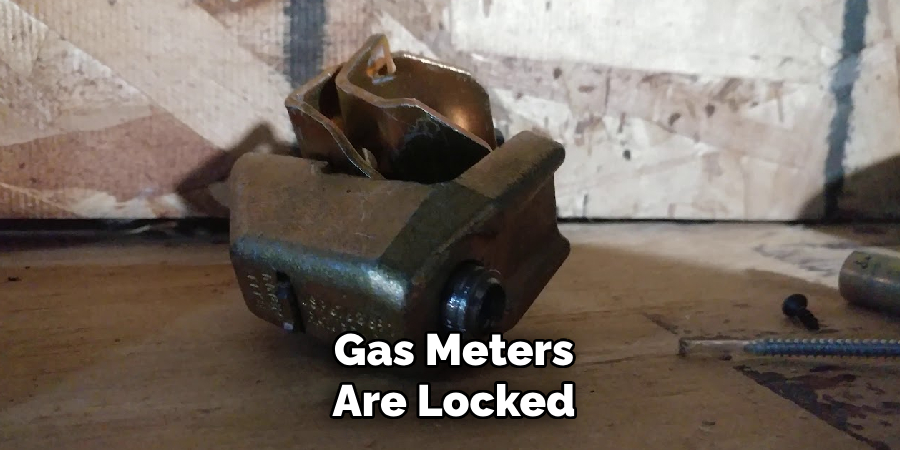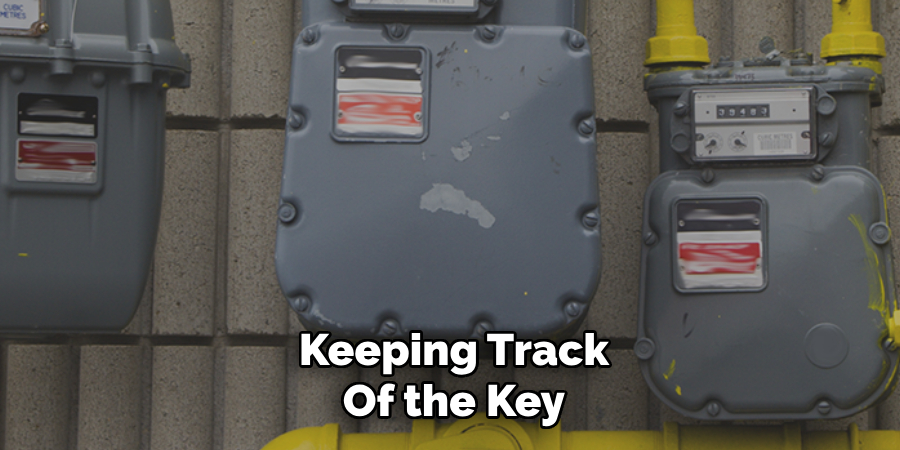Gas meter locks are an essential safety feature used to secure gas meters and prevent unauthorized access. These locks help ensure that the gas supply remains tamper-proof, reducing risks of misuse and accidents. However, there are instances where one might need to open a gas meter lock without having the key, such as when the key is misplaced or lost or the lock itself becomes faulty.

It’s important to emphasize that attempting to open a gas meter lock without proper authorization can lead to serious consequences, including risks of gas leaks, electrical hazards, or potential damage to the equipment. This article aims to provide a practical guide on how to open gas meter lock without key, intended to help those facing this situation while adhering to all necessary safety precautions and legal considerations. Always prioritize safety and consult with professionals when in doubt.
Understanding the Gas Meter Lock and Its Purpose
Gas meter locks are essential tools designed to ensure the safety and security of gas utility systems. These locks are specifically implemented to restrict unauthorized access to gas meters, which could lead to dangerous situations or tampering. There are several types of gas meter locks, each serving a slightly different purpose:
Types of Gas Meter Locks
- Cylinder Locks
Cylinder locks are the most common type, requiring a physical key to unlock. They are effective for residential and commercial properties where controlled access is necessary.
- Padlocks
Padlocks are sometimes used in certain regions and are secured using a simple key. While not as specialized as other locks, they are straightforward and provide a basic level of security.
- Tamper-Proof Locks
These locks are specifically designed to prevent unauthorized tampering. Often, they require a unique tool or method to open, making them ideal for higher security needs.
Why Gas Meters Are Locked
Gas meters are locked primarily to ensure that only authorized personnel, such as utility workers, can access them. This is crucial for maintenance, emergency services, or accurate meter reading. Additionally, locking gas meters prevents unauthorized tampering, protecting residential or commercial properties from potential safety risks, gas leaks, or equipment damage.

By understanding the purpose and types of gas meter locks, individuals can appreciate their importance in maintaining safety and security.
Safety Precautions
Safety First
Never attempt to open a gas meter lock if you suspect a gas leak. If you smell gas, immediately leave the area and contact your gas utility company or emergency services. Do not use open flames, electrical devices, or anything that could ignite the gas. Always prioritize your safety and that of others around you. Additionally, avoid using harsh methods or tools to tamper with the lock, as this can damage the gas meter and create safety risks, such as gas leaks or equipment failure.
When to Call a Professional
If you are unsure how to proceed with a locked gas meter, reaching out to a professional is the safest option. Contact your utility company or a licensed technician in the following scenarios:
- The lock appears to be malfunctioning or damaged.
- You cannot open the lock without potentially compromising safety or damaging the meter.
Professionals have the appropriate tools and training to handle these situations safely, minimizing risks for you and your property.
Gas Shutoff Valve
Before opening a gas meter lock, ensure the gas supply is turned off using the gas shutoff valve. This critical step prevents accidents and ensures a safer process, whether for maintenance or in an emergency. Always follow safety procedures diligently and seek expert guidance when in doubt.
How to Open Gas Meter Lock without Key: Without a Key
Method 1: Using a Lock Picking Tool
Lock picking is a skillful and precise method for opening cylinder locks without causing damage.

Tools needed: Lock pick set and tension wrench.
Step-by-step:
- Insert the lock pick into the keyhole, targeting the pins inside the lock.
- Use the tension wrench to apply gentle pressure in the direction the lock turns.
- Manipulate the pins one by one with the lock pick until all are aligned and the lock rotates open.
This method requires practice and experience, and handling the tools carefully is crucial to avoid damaging the lock mechanism.
Method 2: Using a Bypass Tool
For some gas meter locks, specialized bypass tools can be effective. These tools are designed to apply a specific amount of force to release the lock, bypassing the internal mechanism.
Caution: This method should only be attempted by trained professionals, as improper use may damage the lock or the meter. These tools are not universally applicable and require expertise to ensure safety and success.
Method 3: Using a Bolt Cutter (Last Resort)
If the lock is a simple padlock and no other viable methods, a bolt cutter can be used as a last resort.
Steps:
- Position the bolt cutter’s jaws around the lock’s shackle.
- Apply steady pressure to cut through the lock.
Important Note: This method permanently damages the lock and should only be used in emergencies. Additionally, ensure proper authorization before proceeding to avoid legal or safety issues.
Always consult with a professional and follow legal guidelines when attempting to open a gas meter lock without a key.
Calling the Gas Utility Company for Assistance
Why Contact the Gas Company

Gas meter locks are typically the utility company’s property, and it is crucial to involve them in cases where access to the meter is needed. These companies are trained to safely open and replace locks without causing any damage to the meter or its associated safety features. By contacting the gas utility, you ensure that the lock is handled properly and that any necessary adjustments are performed in compliance with safety standards.
What to Expect When You Call
When reaching out to the gas utility company, be prepared to provide proper identification and explain the reason you need access to the meter. This helps the company verify your request and determine the appropriate course of action. Generally, the gas company will dispatch a trained technician to safely unlock the meter and address any related concerns.
Costs and Services
The cost of unlocking a gas meter lock can vary depending on the utility company. Some companies may provide this service free of charge or for a nominal fee, while others may charge based on their policies. If you intend to replace the lock, inquire about the options and associated costs to ensure a seamless process. Always verify these details directly with the gas company to avoid misunderstandings.
When You Should Replace the Gas Meter Lock
Replacing a gas meter lock is necessary in certain situations to ensure safety, security, and accessibility.
Reasons for Lock Replacement
- If the lock is damaged or compromised, it may fail to secure the meter effectively.
- If the lock’s key is lost or no longer works, accessing the meter becomes difficult and inconvenient.
- If the lock is old or corroded, it can be challenging to open, posing additional risks during emergencies.
Steps for Replacing a Lock
- Contact your utility provider to request a lock replacement.
- A certified technician will come and replace the existing lock with a new one, ensuring the meter remains secure and operational.
Choosing a New Lock
- When arranging for a replacement, inquire about available lock options that might offer added security or functionality.
- Consider locks that can be more easily accessed in emergencies or those made of durable materials to withstand weather and wear.
Taking these steps ensures your gas meter stays both secure and accessible when needed, giving you peace of mind about its condition and safety. Always consult with your utility provider for guidance and approved practices.
Preventative Measures to Avoid Lock Issues
Keeping Track of the Key

Keep the gas meter lock key in a secure location where it is easily accessible to authorized individuals. This minimizes the risk of losing the key and ensures a swift response during emergencies. It’s also a good idea to label the key discreetly, so it isn’t confused with others but doesn’t reveal its purpose to unauthorized people.
Regular Maintenance of Gas Meter Locks
Routine maintenance plays a critical role in keeping your gas meter lock in optimal condition. During scheduled inspections, have the lock checked for proper functionality and any signs of damage. Additionally, periodically clean the lock to remove dirt, debris, and moisture, which can lead to rust or corrosion over time. Using a lubricant approved for locks can also prevent jamming and ensure smooth operation.
Upgrading to a More Accessible Lock
If the existing lock is outdated, difficult to use, or prone to frequent issues, consider requesting an upgrade from your utility provider. Modern locks often offer enhanced accessibility and durability, making them easier to manage while maintaining security. Consulting your utility provider about options can help you select a lock that meets your needs while complying with any regulations.
Conclusion
Understanding how to open gas meter lock without key access can ensure you are prepared for various situations. Methods such as using lock-picking tools, bypass tools, or bolt cutters should only be considered when absolutely necessary and with caution. Safety must always remain a priority; it is best to call a professional to handle the task if you are unsure or uncomfortable. Additionally, if you regularly face issues with your gas meter lock, consider contacting your utility provider for a replacement lock or maintenance to prevent future difficulties and ensure secure, efficient access.
About
Safety Fic is a distinguished figure in the world of Diy design, with a decade of expertise creating innovative and sustainable Diy solutions. His professional focus lies in merging traditional craftsmanship with modern manufacturing techniques, fostering designs that are both practical and environmentally conscious. As the author of diy, Safety Fic delves into the art and science of Safety Fic-making, inspiring artisans and industry professionals alike.
Education RMIT University
(Melbourne, Australia) Associate Degree in Design (Safety Fic) Focus on sustainable design, industry-driven projects, and practical craftsmanship. Gained hands-on experience with traditional and digital manufacturing tools, such as CAD and CNC software.
Nottingham Trent University
(United Kingdom) Bachelor’s in diyfastly.com and Product Design (Honors) Specialized in product design with a focus on blending creativity with production techniques. Participated in industry projects, working with companies like John Lewis and Vitsoe to gain real-world insights.
Publications and Impact
In diy, Safety Fic his insights on indoor design processes, materials, and strategies for efficient production. His writing bridges the gap between artisan knowledge and modern industry needs, making it a must-read for both budding designers and seasoned professionals.
